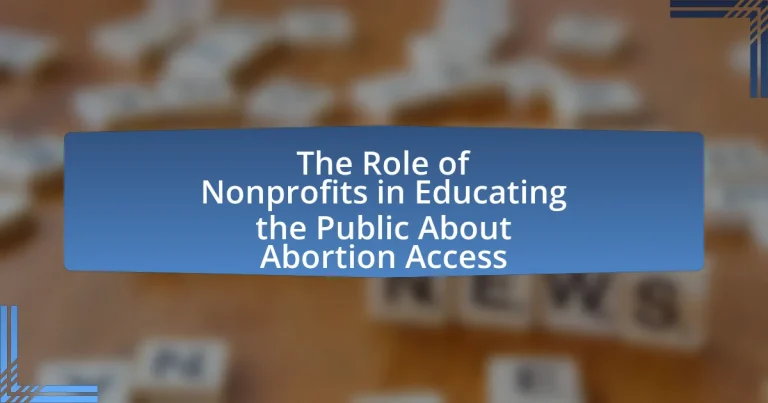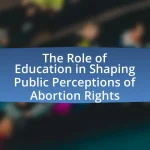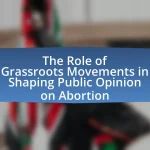Nonprofits play a vital role in educating the public about abortion access by providing accurate information, resources, and advocacy efforts. They conduct outreach programs, distribute educational materials, and engage in policy advocacy to inform individuals about their reproductive rights and available services. Key strategies include community workshops, digital campaigns, and partnerships with healthcare providers and community organizations, all aimed at dispelling misconceptions and stigma surrounding abortion. The article also addresses the challenges nonprofits face, such as misinformation, funding limitations, and social stigma, while highlighting best practices for enhancing educational impact and effectively engaging target audiences.
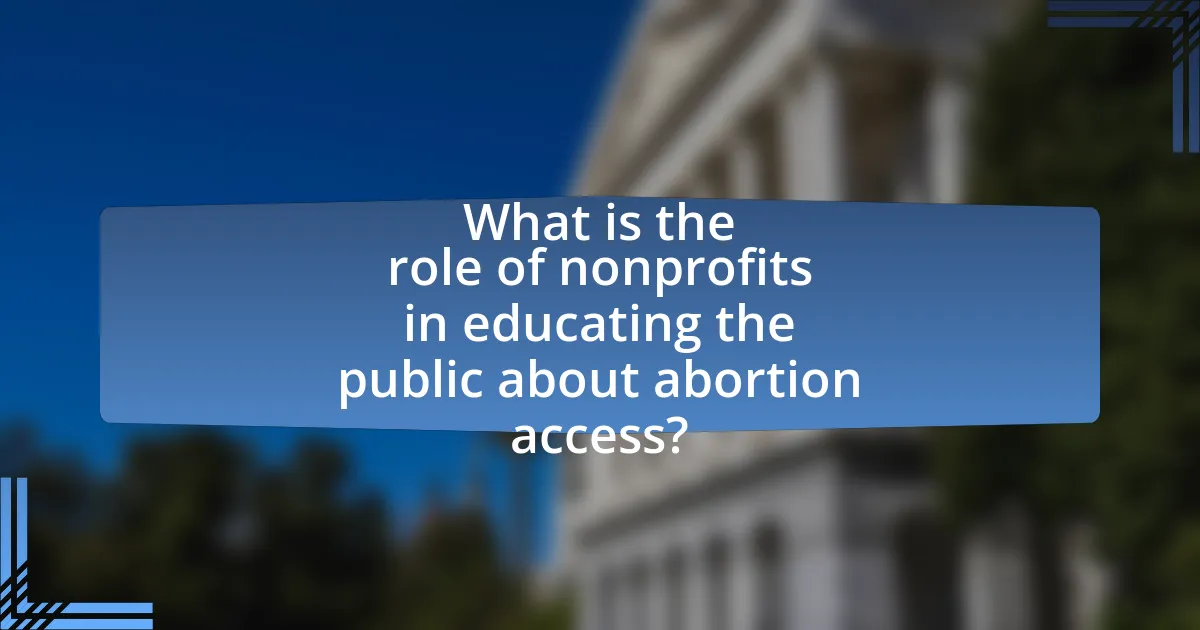
What is the role of nonprofits in educating the public about abortion access?
Nonprofits play a crucial role in educating the public about abortion access by providing accurate information, resources, and advocacy. They often conduct outreach programs that inform individuals about their reproductive rights and available services, addressing misconceptions and stigma surrounding abortion. For instance, organizations like Planned Parenthood offer educational materials and workshops that clarify legal rights and access to healthcare services, which is essential given that 1 in 4 women in the U.S. will have an abortion by age 45, according to the Guttmacher Institute. Additionally, nonprofits engage in policy advocacy to influence legislation related to abortion access, ensuring that the public is aware of changes that may affect their rights. This multifaceted approach helps empower individuals to make informed decisions regarding their reproductive health.
How do nonprofits contribute to public awareness regarding abortion access?
Nonprofits contribute to public awareness regarding abortion access by providing education, resources, and advocacy efforts aimed at informing the community. These organizations often conduct outreach programs, distribute informational materials, and host events to discuss the implications of abortion access, thereby increasing knowledge and understanding among the public. For instance, the Guttmacher Institute reports that comprehensive sex education and access to reproductive health services, often promoted by nonprofits, lead to better-informed communities about their reproductive rights and options. Additionally, nonprofits engage in policy advocacy, influencing legislation and public opinion, which further amplifies awareness and accessibility of abortion services.
What specific educational programs do nonprofits implement?
Nonprofits implement specific educational programs such as community workshops, informational campaigns, and online resources focused on abortion access. These programs aim to raise awareness about reproductive rights, provide accurate information regarding abortion services, and educate individuals on legal and health-related aspects of abortion. For instance, organizations like Planned Parenthood offer workshops that cover topics such as contraception, pregnancy options, and the importance of reproductive health education, which are essential for informed decision-making. Additionally, nonprofits often utilize social media campaigns to disseminate information quickly and effectively, reaching a broader audience and addressing misconceptions about abortion access.
How do these programs address misconceptions about abortion?
These programs address misconceptions about abortion by providing accurate information and resources that counter prevalent myths. For instance, they often utilize evidence-based education to clarify the medical, psychological, and social aspects of abortion, thereby dispelling false narratives. Research indicates that comprehensive education initiatives can significantly reduce stigma and misinformation; a study published in the American Journal of Public Health found that individuals who received accurate information about abortion were more likely to have a positive understanding of the procedure. By engaging communities through workshops, informational campaigns, and accessible literature, these programs effectively challenge and correct misconceptions surrounding abortion.
Why is public education on abortion access important?
Public education on abortion access is important because it empowers individuals with accurate information, enabling informed decision-making regarding reproductive health. Access to comprehensive education helps dispel myths and misconceptions surrounding abortion, which can lead to stigma and misinformation. For instance, studies show that states with comprehensive sex education and abortion information have lower rates of unintended pregnancies and abortions, highlighting the effectiveness of informed public discourse. Furthermore, public education initiatives can increase awareness of available resources and support services, ensuring that individuals understand their rights and options.
What impact does misinformation have on public perception of abortion?
Misinformation significantly distorts public perception of abortion by fostering misconceptions and reinforcing stigma. Studies indicate that false narratives about abortion, such as exaggerated claims regarding its physical and psychological effects, lead to increased opposition and fear among the public. For instance, a survey by the Guttmacher Institute found that individuals exposed to misinformation were more likely to hold negative views about abortion and its safety. This skewed perception can hinder informed decision-making and reduce support for abortion access initiatives, ultimately impacting policy and healthcare services related to reproductive rights.
How does education influence policy and access to abortion services?
Education significantly influences policy and access to abortion services by shaping public opinion and informing legislative decisions. When individuals are educated about reproductive health and rights, they are more likely to advocate for policies that support access to abortion services. For instance, studies have shown that comprehensive sex education correlates with lower rates of unintended pregnancies and higher rates of contraceptive use, which can lead to increased support for abortion access as a necessary component of reproductive healthcare. Furthermore, organizations like Planned Parenthood provide educational resources that empower communities, leading to greater advocacy for policies that protect and expand abortion rights. This educational impact is evident in various states where informed public opinion has led to the introduction of more supportive legislation regarding abortion access.
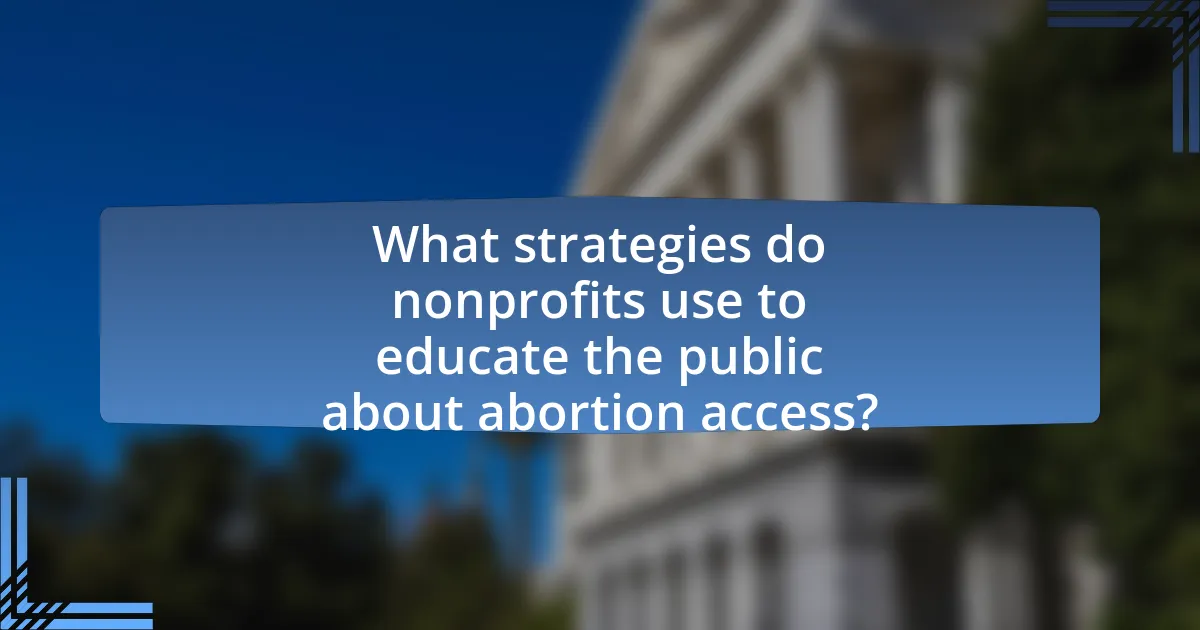
What strategies do nonprofits use to educate the public about abortion access?
Nonprofits utilize various strategies to educate the public about abortion access, including community outreach programs, educational workshops, and digital campaigns. Community outreach programs often involve partnerships with local organizations to provide information and resources directly to underserved populations, ensuring that accurate information reaches those who may lack access. Educational workshops are designed to inform individuals about reproductive rights, legal aspects of abortion, and available services, often featuring healthcare professionals and legal experts as speakers. Digital campaigns leverage social media platforms to disseminate information quickly and widely, utilizing infographics, videos, and testimonials to engage and inform the public. These strategies are supported by research indicating that informed communities are more likely to advocate for and access reproductive health services, thereby highlighting the effectiveness of these educational efforts.
How do nonprofits utilize social media for education on abortion access?
Nonprofits utilize social media to educate the public on abortion access by disseminating accurate information, raising awareness about reproductive rights, and mobilizing community support. They create and share content such as infographics, videos, and articles that clarify legal rights and available services, often targeting specific demographics to enhance engagement. For instance, organizations like Planned Parenthood leverage platforms like Twitter and Instagram to reach millions, providing resources and updates on legislation affecting abortion access. Research indicates that social media campaigns can significantly increase public knowledge and advocacy efforts, as evidenced by a 2020 study published in the Journal of Health Communication, which found that targeted social media messaging improved awareness of reproductive health services by 30%.
What types of content are most effective in raising awareness?
Visual content, such as infographics and videos, is most effective in raising awareness. Research indicates that visual information is processed 60,000 times faster than text, making it more engaging and memorable for audiences. Additionally, social media platforms, which prioritize visual content, have shown that posts with images receive 94% more views than those without. Nonprofits focusing on abortion access can leverage these types of content to effectively communicate their messages and educate the public.
How do nonprofits measure the impact of their social media campaigns?
Nonprofits measure the impact of their social media campaigns through metrics such as engagement rates, reach, conversion rates, and audience growth. These metrics provide quantitative data that helps organizations assess how effectively their campaigns are resonating with the target audience. For instance, engagement rates indicate how many users interacted with the content, while reach measures the total number of unique users who saw the posts. Additionally, conversion rates track specific actions taken by users, such as signing petitions or donating, which directly relate to campaign goals. By analyzing these metrics, nonprofits can refine their strategies and improve future campaigns, ensuring they effectively educate the public about abortion access.
What partnerships do nonprofits form to enhance their educational efforts?
Nonprofits enhance their educational efforts by forming partnerships with educational institutions, healthcare providers, and community organizations. These collaborations allow nonprofits to leverage resources, expertise, and networks to disseminate information effectively. For instance, partnerships with universities can facilitate research and provide access to academic resources, while collaborations with healthcare providers can ensure that accurate medical information reaches the public. Additionally, working with community organizations helps nonprofits engage directly with target audiences, fostering trust and improving outreach effectiveness. Such strategic alliances are essential for maximizing impact and ensuring that educational initiatives are well-informed and widely accessible.
How do collaborations with healthcare providers improve outreach?
Collaborations with healthcare providers improve outreach by leveraging their established trust and credibility within communities. When nonprofits partner with healthcare professionals, they can effectively disseminate accurate information about abortion access, thereby reaching a wider audience. For instance, a study published in the American Journal of Public Health found that community-based interventions involving healthcare providers increased awareness of reproductive health services by 40%. This demonstrates that such collaborations not only enhance the visibility of educational efforts but also foster a supportive environment for individuals seeking information about abortion access.
What role do community organizations play in supporting nonprofit initiatives?
Community organizations play a crucial role in supporting nonprofit initiatives by providing resources, outreach, and advocacy. They often serve as local hubs that connect nonprofits with the communities they aim to serve, facilitating access to information and services. For instance, community organizations can mobilize volunteers, raise funds, and enhance awareness about specific issues, such as abortion access, thereby amplifying the impact of nonprofit efforts. Research indicates that community engagement significantly increases the effectiveness of nonprofit programs, as seen in initiatives that successfully educate the public about reproductive health.
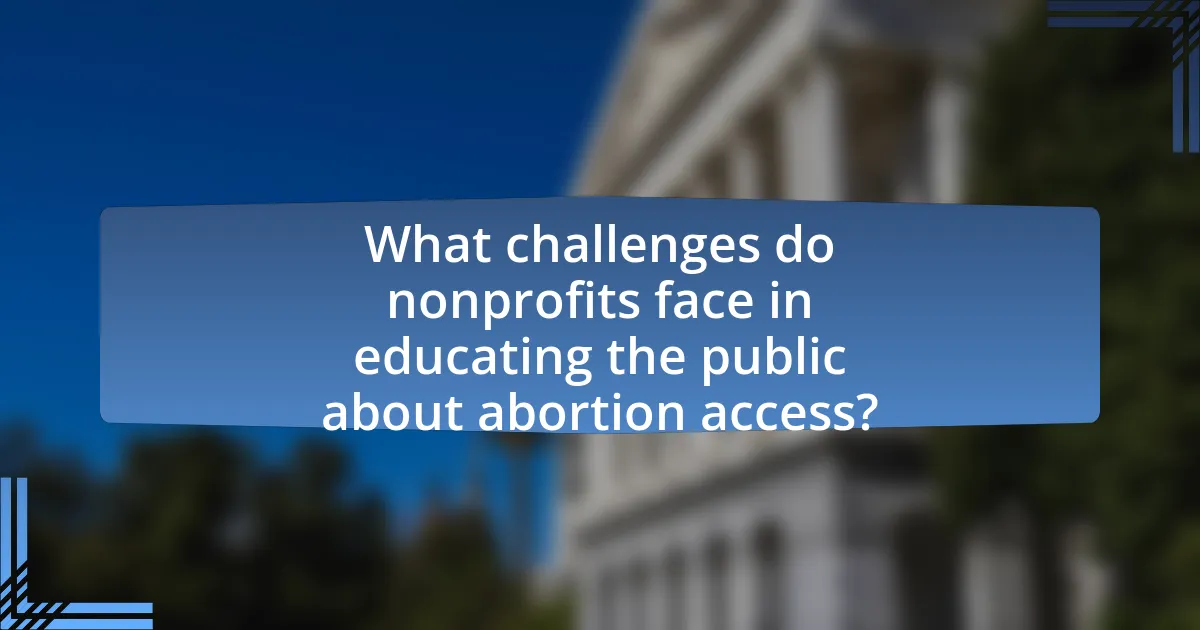
What challenges do nonprofits face in educating the public about abortion access?
Nonprofits face significant challenges in educating the public about abortion access, primarily due to misinformation and stigma surrounding the topic. Misinformation can lead to public confusion about the legality and availability of abortion services, making it difficult for nonprofits to convey accurate information. Stigma surrounding abortion often results in social and political pushback, which can hinder outreach efforts and limit funding opportunities. Additionally, restrictive laws in various regions can create barriers to providing comprehensive education and resources, further complicating nonprofits’ missions to inform the public effectively.
How do funding limitations affect nonprofit educational programs?
Funding limitations significantly hinder nonprofit educational programs by restricting their ability to deliver comprehensive services and outreach. Nonprofits often rely on grants and donations to operate, and when funding is insufficient, they may reduce staff, limit program offerings, or cut essential resources. For instance, a study by the National Council of Nonprofits found that 70% of nonprofits reported that funding constraints directly impacted their ability to fulfill their missions. This is particularly critical in the context of educating the public about abortion access, where effective outreach and education are vital for informed decision-making. Consequently, funding limitations can lead to decreased public awareness and understanding of abortion access, ultimately affecting community health outcomes.
What strategies can nonprofits employ to overcome financial barriers?
Nonprofits can employ diverse strategies to overcome financial barriers, including diversifying funding sources, enhancing fundraising efforts, and building partnerships. Diversifying funding sources allows nonprofits to reduce reliance on a single income stream, which can include grants, donations, and earned income from services. For instance, according to the National Council of Nonprofits, organizations that utilize multiple funding avenues are more resilient during economic downturns. Enhancing fundraising efforts through campaigns, events, and online platforms can significantly increase revenue; the Fundraising Effectiveness Project reported that organizations that actively engage in fundraising see a 20% increase in contributions. Building partnerships with businesses and other nonprofits can also provide access to additional resources and funding opportunities, as collaborative efforts often attract larger grants and sponsorships.
How do political climates impact nonprofit efforts in abortion education?
Political climates significantly influence nonprofit efforts in abortion education by shaping funding availability, public perception, and regulatory environments. For instance, in more conservative political climates, nonprofits may face reduced funding from government sources and increased scrutiny, which can hinder their ability to provide comprehensive education on abortion access. Conversely, in liberal political climates, nonprofits often receive more support and can operate with fewer restrictions, allowing them to disseminate information more freely. Research indicates that states with supportive policies for reproductive health see higher levels of nonprofit engagement in education efforts, as evidenced by the Guttmacher Institute’s findings on state-level abortion policies and nonprofit activity.
What legal and social obstacles do nonprofits encounter?
Nonprofits encounter legal obstacles such as regulatory compliance, tax-exempt status requirements, and restrictions on political activities. For instance, the Internal Revenue Service mandates that 501(c)(3) organizations must adhere to specific guidelines to maintain their tax-exempt status, which can limit their advocacy efforts. Social obstacles include stigma surrounding abortion, which can hinder public support and funding opportunities. Research indicates that organizations addressing abortion access often face backlash from communities opposed to their mission, impacting their ability to operate effectively.
How do restrictive laws influence nonprofit operations?
Restrictive laws significantly limit nonprofit operations by imposing regulations that can hinder their ability to raise funds, provide services, and advocate for causes. For instance, laws that restrict funding sources or impose stringent reporting requirements can reduce financial resources available for nonprofits, thereby affecting their outreach and educational efforts. A study by the National Council of Nonprofits highlights that nonprofits operating in states with restrictive laws often face increased compliance costs and operational challenges, which can divert attention from their primary mission of educating the public about issues like abortion access.
What social stigmas must nonprofits address in their education efforts?
Nonprofits must address the stigma surrounding abortion as a morally contentious issue in their education efforts. This stigma often leads to misinformation and fear, which can deter individuals from seeking necessary services. Research indicates that 61% of Americans believe abortion should be legal in all or most cases, yet societal stigma persists, influencing public perception and access to care. By providing accurate information and fostering open discussions, nonprofits can combat these stigmas and promote understanding of abortion access as a critical aspect of healthcare.
What best practices can nonprofits adopt to enhance their educational impact?
Nonprofits can enhance their educational impact by implementing evidence-based programs that focus on community engagement and tailored messaging. Research indicates that programs designed with input from the target audience are more effective; for example, a study by the National Campaign to Prevent Teen and Unplanned Pregnancy found that youth-led initiatives significantly increased awareness and understanding of reproductive health issues. Additionally, utilizing data analytics to assess community needs and measure program effectiveness allows nonprofits to adapt their strategies for maximum impact. By fostering partnerships with local organizations, nonprofits can leverage resources and expand their reach, as demonstrated by the collaborative efforts of Planned Parenthood and local health departments, which have successfully increased access to reproductive health education.
How can nonprofits effectively engage their target audiences?
Nonprofits can effectively engage their target audiences by utilizing targeted communication strategies that resonate with specific demographics. For instance, employing social media platforms allows nonprofits to reach younger audiences, while community events can engage local populations directly. Research indicates that 70% of millennials prefer to engage with brands through social media, highlighting its effectiveness for outreach. Additionally, personalized messaging tailored to the interests and values of the audience fosters a deeper connection, as studies show that targeted campaigns can increase engagement rates by up to 50%. By combining these strategies, nonprofits can enhance their visibility and impact in educating the public about abortion access.
What evaluation methods can nonprofits use to assess their educational effectiveness?
Nonprofits can use a variety of evaluation methods to assess their educational effectiveness, including surveys, focus groups, pre- and post-tests, and outcome measurements. Surveys allow organizations to gather quantitative data on participant knowledge and attitudes before and after educational programs, providing measurable insights into effectiveness. Focus groups facilitate qualitative feedback, enabling nonprofits to understand participant experiences and perceptions in depth. Pre- and post-tests assess knowledge gains directly related to the educational content delivered, while outcome measurements track long-term impacts, such as changes in behavior or increased access to abortion services. These methods collectively provide a comprehensive framework for evaluating educational initiatives and their impact on public awareness and access to abortion information.
